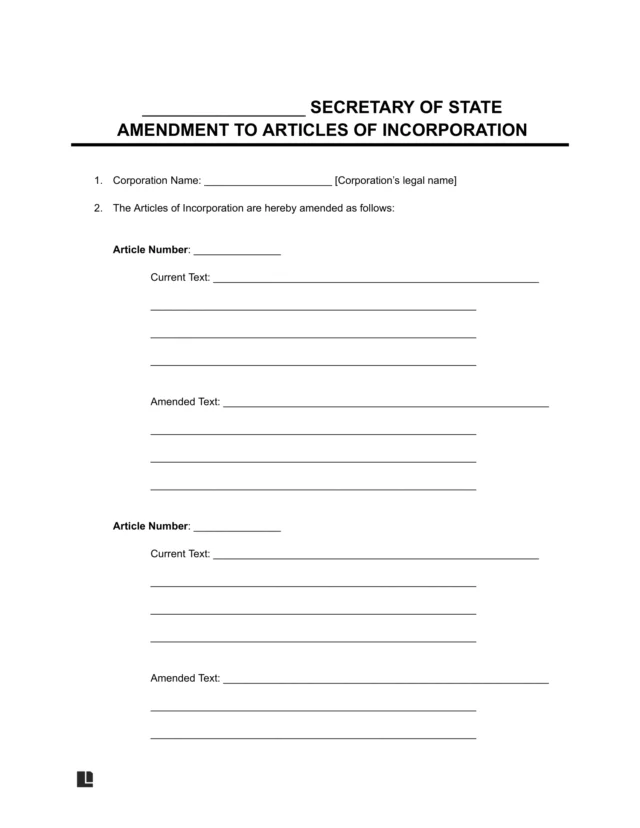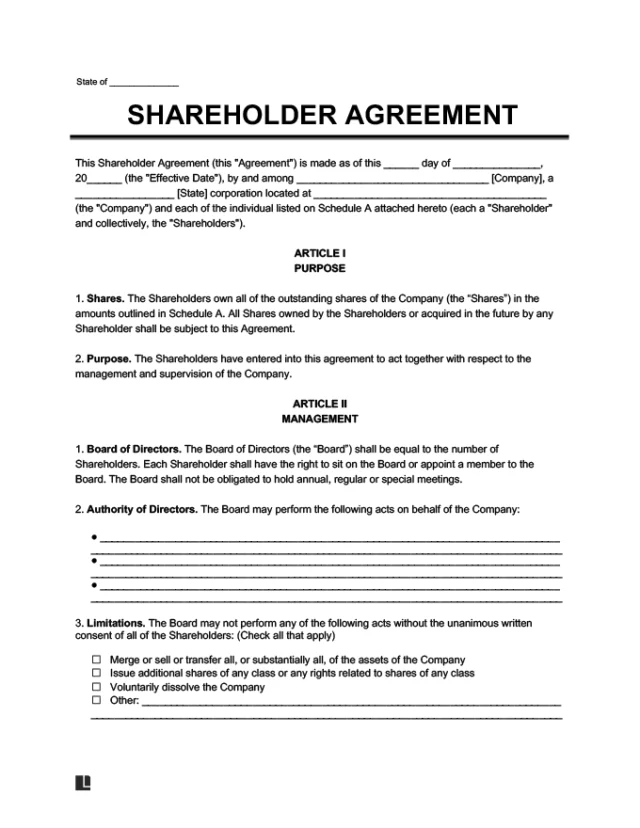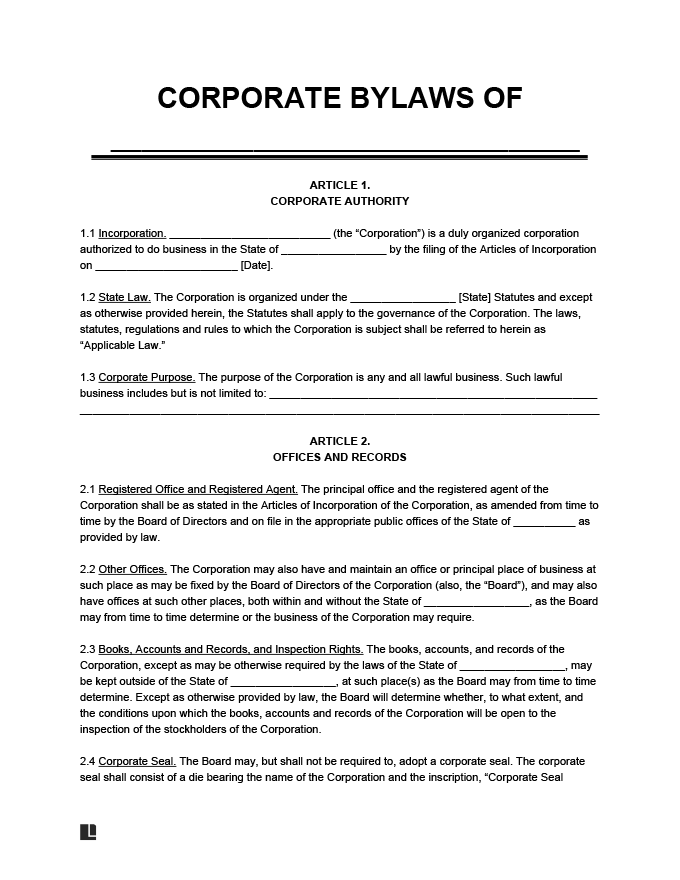Corporate Bylaws – By State
When forming a corporation, you must draft bylaws that comply with state laws to keep your business legally sound and organized. Each state has its rules about what corporate bylaws should include and how to adopt and amend them. Explore our state-specific corporate bylaws templates to meet local requirements and avoid legal issues.
- Alabama
- Alaska
- Arizona
- Arkansas
- California
- Colorado
- Connecticut
- Delaware
- District of Columbia
- Florida
- Georgia
- Hawaii
- Idaho
- Illinois
- Indiana
- Iowa
- Kansas
- Kentucky
- Louisiana
- Maine
- Maryland
- Massachusetts
- Michigan
- Minnesota
- Mississippi
- Missouri
- Montana
- Nebraska
- Nevada
- New Hampshire
- New Jersey
- New Mexico
- New York
- North Carolina
- North Dakota
- Ohio
- Oklahoma
- Oregon
- Pennsylvania
- Rhode Island
- South Carolina
- South Dakota
- Tennessee
- Texas
- Utah
- Vermont
- Virginia
- Washington
- West Virginia
- Wisconsin
- Wyoming
What Are Corporate Bylaws?
Corporate bylaws are documents that record a corporation’s internal operating procedures. They explain the duties of individuals who have direct involvement with the company. Directors and officers refer to the bylaws to make decisions and prevent and resolve conflicts.
Corporate Bylaws vs. Articles of Incorporation
Bylaws differ from articles of incorporation, as the latter need to be filed with the Secretary of State for business formation.
The corporation’s incorporator drafts the bylaws, which determine the course of daily business activities. Then, the bylaws are approved by the board of directors during the initial formation meeting. If there is confusion or disputes during operations, the board can refer to the bylaws for clarity.
Bylaws are important because they keep the corporation running smoothly. They establish key matters, such as:
- How decisions are made
- How meetings are conducted
- How officers are appointed and removed
- How shares are issued
- How day-to-day operations are managed
- How conflicts of interest are handled
Who Are Corporate Bylaws For?
Bylaws are for for-profit corporations (including C-corporations and S-corporations) and nonprofits. Nonprofits can use their bylaws to record their statement of purpose, which is often needed for acquiring tax-exempt status with the IRS.
Are Corporate Bylaws Public?
Corporate bylaws typically remain internal for private companies. However, bylaws may be public if the corporation is a nonprofit. If you’re wondering where to find corporate bylaws for a nonprofit, you can conduct a company search on the US Securities and Exchange Commission.
Do I Need Corporate Bylaws?
The requirement for corporate bylaws varies from state to state. Most states require corporations to have bylaws. Even if your company operates in a state without this requirement, you can still benefit from having them, as they clarify roles and provide concise internal rules.
If you do not have bylaws, you may be subject to your state’s default laws if an internal dispute arises within the company. Below, you can see what states require corporate bylaws.
| State | Required? | Statute |
|---|---|---|
| Alabama | Yes | AL Code § 10A-2A-2.05(a) |
| Alaska | No | AK Stat § 10.06.228, § 10.06.230, and § 10.06.233 |
| Arizona | Yes | AZ Rev Stat § 10-206(A) |
| Arkansas | Yes | AR Code § 4-27-206(a) |
| California | No | CA Corp Code § 210, § 211, § 212, and § 213 |
How to Write Corporate Bylaws
Clear corporate bylaws help a company conduct itself and manage different affairs. Explore how to write them step-by-step, using Legal Templates’ form to guide you.
1. Add the Corporation’s Information
Start by providing the corporation’s information. Give the name, the state in which it was formed, its office address or place of business, and the date it was formed. While optional, you can also provide a brief description of the company’s purpose. This statement guides decision-making, informs company culture, and informs stakeholders about the company’s mission beyond profit-making.
Starting a Nonprofit?
If you’re starting a nonprofit, use Legal Templates’s nonprofit bylaws instead.
2. Write Shareholder Meeting Details
Shareholder meetings let shareholders vote on specific business items, such as deciding on mergers and approving major transactions. Specify the percentage of shareholders who must be present to call a meeting. You can also decide on a quorum, which is the minimum percentage of shares or corporate officials that must be present for action-taking at a meeting.
3. Provide Director Information
State the number of directors required to serve on the company’s board. It’s advisable to have an odd number so there are no ties when the directors make decisions. You should also specify what percentage of shares all shareholders must have to remove a director.
You can also distinguish between shareholder and director meeting quorums. A director meeting quorum is based on the number of people, not the number of shares each director owns. Other director-related details to include are:
- The length of the directors’ terms
- Vacancies
- Resignation
- Removal
- Fees and compensation
- Organization (who will preside over a meeting)
4. Include Officer Details
Bylaws explain the company’s officers and management structure. It can be simple with just a president, secretary, and treasurer. Larger businesses may establish a more complex structure with roles such as:
- Vice president
- Chief financial officer (CFO)
- Chief executive officer (CEO)
- Chief operating officer (COO)
5. Write Stock Guidelines
Write stock guidelines for the issuance and transfer of stocks. You can also outline the procedures for unforeseen circumstances, like lost stock certificates. If the company has the resources to pay dividends, specify the payout process.
6. Outline Indemnification & Insurance Information
Outline whether the corporation will have the power to indemnify its employees, officers, directors, and other agents in connection with actions taken on behalf of the business. If needed, use Legal Templates’s indemnity agreement to write a more detailed contract. Also, specify if the corporation can buy and maintain insurance for one of these parties.
7. Define the Fiscal Year & Annual Report Details
Define the corporation’s fiscal year. Some companies use the calendar year, while others use another 12-month period.
Explain how and when the company will procure an annual report. The report shows the company’s financial performance, so shareholders can learn about its cash flow and overall performance.
8. Sign the Document
While corporate bylaws don’t typically have to be signed, you should acquire the signatures of board members and officers. Their signatures add legitimacy and show that the involved members agreed to adopt the bylaws. Furthermore, notarization isn’t required, but notary acknowledgment can increase the document’s validity.
Sample Corporate Bylaws
View our free corporate bylaws template to understand its format. Then, create your own using our guided form. Download the final document as a PDF or Word file.
How to Amend Corporate Bylaws
As your company grows and continues to operate, you may want to update your bylaws. Follow these steps for amending your bylaws:
- Review existing bylaws: Determine what amendments you wish to make.
- Check state laws: Study statutes on corporate bylaws to see if your state requires you to follow specific procedures for amendments.
- Draft proposed amendments: Write the changes you want to implement. Be clear about what sections you’re changing, removing, or adding.
- Call a meeting: Call a shareholder or director meeting. Issue the notice your bylaws require.
- Conduct a vote: Allow shareholders or board members to vote on the proposed amendments, ensuring you meet the quorum requirements.
- Record the new amendment: If approved, write a corporate resolution summarizing the changes. Record it in the corporate minutes.
- Update your bylaws: Revise them to contain the most current provisions.
- File amendments: If required, file amended bylaws with the appropriate body. In general, this step only applies to nonprofits.
- Notify relevant parties: Inform officers, employees, and other stakeholders of the changes.







